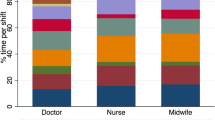Abstract
Objective: To describe a novel method of time analysis for health care settings by quantifying internal medicine housestaff’s work activities and contacts.
Design: Observational work sampling study based on random sampling technique.
Setting: General medicine service in a university hospital.
Participants: All housestaff (18 interns, 18 residents) rotating through the general medicine service during a 12-week period.
Main outcome measures: Proportion of time spent doing 22 work activities and proportion of time spent with 13 work contacts, reported separately for interns and residents and for on-call days and off-call days.
Results: The authors sampled 6,599 unique time observations (3,533 from on-call days, 3,066 from off-call days) during 193 housestaff workdays. The housestaff spent a majority of their time engaged in direct patient care activities (81% of the interns’ workdays, and 64.5% of the residents’ workdays), primarily in patient evaluation and follow-up (48% of the interns’ and 39% of the residents’ workdays). Compared with the interns, the residents spent relatively more time in direct educational activities (conferences, reading, teaching): 27% of the residents’ workdays versus 10% of the interns’ workdays. Analysis of work contacts showed that the housestaff spent a large portion of the workday alone: 27% of the residents’ and 34% of the interns’ workdays. The housestaff also spent a large portion of the workday with attending physicians: 23% of the residents’ and 11% of the interns’ workdays. This translates into 21 hours/week of attending supervision for the residents and 10 hours/week for the interns.
Conclusions: Using random work sampling, the authors found that the vast majority of the houseofficer’s workday was spent in direct patient care. This method of time analysis may be used to describe housestaff training and supervision, as well as to evaluate administrative interventions designed to change housestaff work experience.
Similar content being viewed by others
References
Glickman RM. House-staff training—the need for careful reform. N Engl J Med. 1988;318:780–2.
McCarty DJ. Why are today’s medical students choosing high-technology specialties over internal medicine? N Engl J Med. 1987;317:567–9.
Asch DA, Parker RM. The Libby Zion case: one step forward, or two steps backward? N Engl J Med. 1988;318:771–5.
Levinsky NG. Compounding the error. N Engl J Med. 1988;318:778–80.
McCall TB. No turning back: a blueprint for residency reform. JAMA. 1989;261:909–10.
Petersdorf RG, Bentley J. Residents’ hours and supervision. Acad Med. 1989;64:175–81.
Fallon HJ. Residency reform: a perspective from the Association of Professors of Medicine. Ann Intern Med. 1992;116:1041.
NY. State Dept. of Health ad hoc Advisory Committee on Emergency Services, Supervision and Residents’ Working Conditions. New York, Title X, Health Code 405, Oct 7, 1987.
Robertsen JA. Multi-dimensional work sampling at the executive level. Industrial Eng. 1980;12:70–3.
Roberts MJ, Kvalseth TO, Jermstad RL. Work measurement in hospital pharmacy. Top Hosp Pharmacy Management. 1982;2:1–17.
American College of Physicians. Working conditions and supervision for residents in internal medicine: recommendations. Ann Intern Med. 1989;110:657–63.
Laine C, Goldman L, Soukup JR, Hayes JG. The impact of a regulation restricting medical house staff working hours on the quality of patient care. JAMA. 1993;269:374–8.
Lurie N, Rank B, Parenti C, Woolley T, Snoke W. How do house officers spend their nights? N Engl J Med. 1989;320:1673–7.
Parenti C, Lurie N. Are things different in the light of day? A time study of internal medicine house staff days. Am J Med. 1993;94:654–8.
Nerenz D, Rosman H, Newcomb C, et al. The on-call experience of interns in internal medicine. Arch Intern Med. 1991;150:2294–7.
Dolan KL, Rosner F, Spiegel D. Survey of nonphysician tasks performed by medicine residents at a municipal hospital. J Natl Med Assoc. 1990;82:629–33.
Oddone E, Guarisco S, Simel D. Comparison of housestaff’s estimates of their workday activities with results of a random work-sampling study. Acad Med. 1993;68:859–61.
Arthurson J, Mander-Jones T, Rocca J. What does the intern do? Med J Australia. 1976;1(3):63–5.
Payson HE, Gaensien EC Jr, Stargardter FL. Time study of an internship on a university medical service. N Engl J Med. 1961;264:439–43.
Gillanders W, Heiman M. Time study comparisons of 3 intern programs. J Med Educ. 1971;46:142–9.
Author information
Authors and Affiliations
Additional information
Supported in part by the A. W. Mellon Foundation. Dr. Oddone is supported by the VA Health Services Research career development program.
Rights and permissions
About this article
Cite this article
Guarisco, S., Oddone, E. & Simel, D. Time analysis of a general medicine service. J Gen Intern Med 9, 272–277 (1994). https://doi.org/10.1007/BF02599655
Issue Date:
DOI: https://doi.org/10.1007/BF02599655




